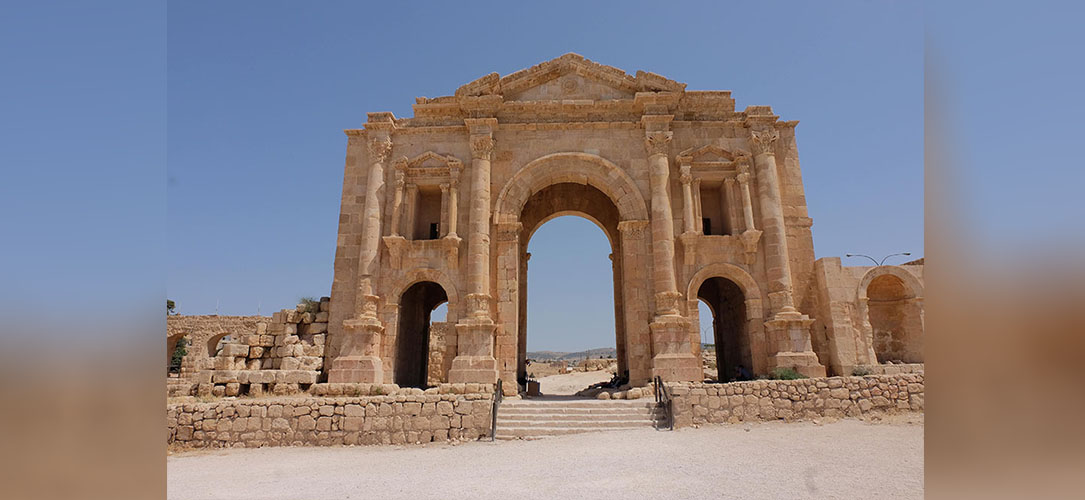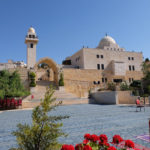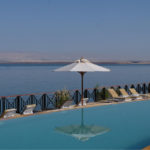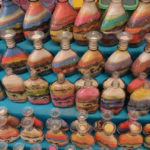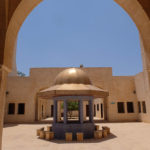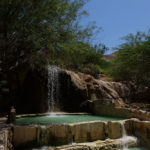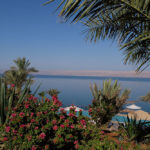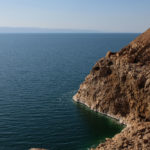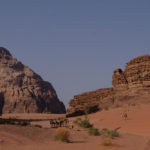*Aidha Cader unravels the many beauties of Jordan in the midst of geopolitical mayhem in the region A Region in Turmoil The Iconic Photo Ops “Its familiarity does not diminish its majesty when you see it for yourself”. After a day of sightseeing we drove for two hours south towards Wadi Rum. This is the spectacular desert that T E Lawrence described as, “vast, echoing and godlike” in his book The Seven Pillars of Wisdom. A shaft of light broke through the clouds and swept across the dunes basking it in golden hues. It’s been a hundred years since Lawrence and the Arab revolt that not only ended five hundred years of Ottoman rule, but also redrew the map of the Middle East. Lawrence’s betrayal and the British-French double deal still taste bitter as our guide Hosam, reflects on their deception. We arrived at Mazayen Rum Camp at dusk and climbed up to the adjacent dune to watch the aurora of colours reflect off the landscape as the sun sets. The following day, we woke up before dawn and took a camel ride across the desert to watch the sun rise. Next, we swapped camels for four-wheel pickup trucks and ventured further into the Wadi Rum, stopping at a local Bedouin tent for sage tea and refreshments. “The broad, rusty plains set between towering granite and sandstone ridges feel like a Martian terrine, if not for the occasional wild camels grazing on thorny shrubs that brings us back to earth”. We continue our journey further west to the port city of Aqaba. From this beach side resort we hopped on to a private boat and cruised along the Red sea. “Over there,” pointing north, “that is Israel and over there, towards the west is Egypt,” says the captain. Few minutes later he points towards the south and says, “look, that is Saudi Arabia”, and then gestures towards the east, “of course, that is Jordan.”After an hour of cruising these waters, we drop the anchor and plunge in with our snorkelling gear. The waters are calm and clear as we swim a short distance away from the boat to look upon a dazzling array of marine life. After lunch on board we head back to dry land and travel north towards the Dead Sea. At the Mövenpick Resort & Spa we walk along its private beach and then float over the Dead Sea as the sun sets, a somewhat surreal experience. Located at the lowest point on earth, the Dead Sea is 8.6 times saltier than others and exhibits a natural buoyancy that makes you float. Its hyper salinity stings even the smallest bruise on the skin and though it makes the perfect photo opt, before long I wanted to rinse off and dip into the chlorinated private jacuzzi adjacent to our room. The resort is laid out over seven hectares of gardens, swimming pools and sandstone buildings designed to replicate an Arabian village. It not only creates a luxury feel but also showcases the region’s rich legacy of art and architecture. Off the Beaten Path Off the beaten path, one hour from Amman towards the east are the remains of the 8th century Umayyad desert castles of Qasr Kharana and Qasr Amra. “The most outstanding features of this small pleasure palace at Qasr Amra are its richly decorated figurative murals that reflect the secular art of the time.” Jordan also has plenty of Islamic and Biblical sites and has been on the crossroads of the pilgrim trail for all three monotheistic religions. The legendary Mount Nebo, 35km west of Amman is the site where the prophet, Moses looked upon the Promised Land on the horizon, a land he was himself was forbidden to enter. The tombs of Prophets Moses, Noah, Aaron, Joshua, Jethro, the cave of the Prophet Lot and Moses’s spring are also dotted along the pilgrim trail, which we visited. The cave of the seven sleepers mentioned in the Quran, the blessed tree that the Prophet rested under while travelling in a trade caravan as a boy with his uncle and the original letter sent by the Prophet to the Byzantine king Heraclius, inviting him to Islam, housed at the beautiful King Hussein Mosque are sites not to be missed. There are also many companions of the Prophet whose tombs mark a special veneration across the country, which we took time out of our touristy itinerary to stop and pay our due respects to. Jordanian Hospitality *Photographs by Aidha Cader
Our journey began in Amman, the capital of Jordan. A few days before our arrival there had been wide spread protests against the IMF recommended austerity measures put in place by the government. Jordan is one of the few countries in the Middle East that is devoid of modernity’s cash crop, oil. It is also one of the countries that opened its borders to Palestinian refugees since the creation of Israel, 70 years ago. Jordan has seen a wave of Iraqi refugees during the US-led invasion and hordes of Syrians refugees as a result of the ongoing civil war. To further exacerbate its financial woes, tourism, one of its main income generators, has been on a downward trajectory since the Arab Spring. Despite Jordan’s worrying statistics, we were often reminded by the locals that there is no ISIL here. As well as being safe, the historical sites have become relatively empty in recent years and devoid of the throngs of tourists with their selfie sticks and disposable maps. Ironically, it felt like a blessing for the likes of us who decided to visit it over the summer.
A wonder of the world and a UNESCO world heritage site, Petra is Jordan’s most visited attraction. The ancient Nabataeans incised these structures deep into the mountains during the first century B.C. which later became a Roman trading city-state. However, its dominance declined as the incoming Arabs favoured the sea routes instead. The legendry ‘Lost City’, chronicled in ancient manuscript, was rediscovered in 1812 by Johann Ludwig Burckhardt who lived with the Bedouins and gained their trust in an attempt to uncover the site. Its pink rock cut colonnaded structures have captured the imagination of filmmakers and travellers alike. To experience the magnificent Al Khazneh or ‘The Treasury’, we walked through the 1.2km gorge called the Siq, reminiscing Indiana Jones and the Last Crusades.
Next, we saddled some donkeys and climbed 800 steps up to the Monastery, a temple carved into the mountain summit. Dotted along the route are many Royal tombs, which the 12 year old boy in charge of our donkeys eagerly pointed towards.
Beyond the bucket-list sites, Jordan has some of the best-preserved Greco-Roman architectural remains. In Amman, we visited the citadel, the amphitheatre and later drove north to the city of Jerash. The country also holds numerous crusader castles built during the reign of Saladin in the 12th century. These include, Ajloun, Shobak, Kerak and Azraq. Built on the land routes between Damascus and Mecca, a climb to the top of the summits showcases its strategic importance. The castles still hold their battle scars reminding the visitors of their turbulent pasts.
Jordan is a foodie’s dream come true and its flavours are etched in my memory many months even after our vacation. Between Mansaf, the national dish with chunks of lamb cooked in dried yogurt on a bed of rice with a fine pita at the base that we enjoyed at Tawaheen Al Hawa restaurant, to the humble falafel at Al Quds on Rainbow street, to the BBQ known as Zarb cooked under the sands of the Wadi Rum, to the never ending array of Kebabs, Humus, Babaganoush and the countless varieties of nut filled Baklava, cheese filled Kunafe, that we gulped down with Mint tea and Arabic coffee, the food is to die for.
Everyone we meet echoes “Ahlan wa Sahlan” which means, “welcome” but also refers to “make yourself at home” a characteristic ingrained in Jordan’s Bedouin tradition.
Jordanian have made Middle Eastern hospitality an art form and rarely complain of their current predicament. This for me is all the more reason to visit the country, to give hope to a nation holding on to optimisms and endurance in a region engulfed with strife.
An Oasis in a Desert Storm
